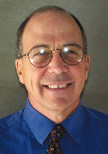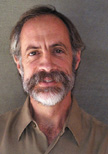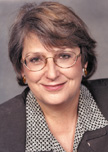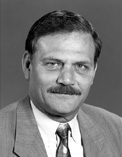geotimesheader
Society
Page
News about
people and
announcements
from
AGI's 35
member societies
______________________ |
To
post news in Society Page, send e-mail to geotimes@agiweb.org
with the subject: Society Page. |
Contents:
Special
awards presented to 'Junior Nobel Laureates'
The American Geological Institute (AGI) presented special awards to
International Science and Engineering Fair 2000 participants on May 13.
Carolyn Morgan Tewksbury, 14, a freshman at Clinton Senior High in Clinton,
N.Y., won AGI’s first place prize of $300 for her project: Shield Volcanoes,
Coronae and Lithospheric Evolution on Venus.
AGI awarded its second place prize of $200 to Vanessa McGee Crawford,
17, a senior at Tucson Magnet High, Tucson, Ariz. Vanessa won for her project:
Cyanobacteria vs. Mars — Can Cyanobacteria Survive Mars-Like Conditions?
María Piedad Rossi, 16, a sophomore at Colegio de la Salle in
Talca, Septemia Region, Chile, won AGI’s third prize of $100 for her project:
Nucleation Process and Isomorphism in Ionic Salts.
Austin Anthony DeCock, 18, a senior at Lake Park/Audubon High School
in Lake Park, Minn., won an AGI honorable mention for his three-year study:
Simulating Hydric Conditions in Non-Hydric Soils to Redoximorphically Define
Wetlands.
Cassandra Lynn Koemer and Lynnessa Kellogg, both 16-year-old juniors
at Stevensville High School in Stevensville, Mont., won AGI honorable mentions
for their two-year study: Effects of Land Use on Geomorphology and Water
Quality of North Burst Fork Creek.
Joy Claire Womack, 17, a senior at Billings West High School in Billings,
Mont., won an AGI honorable mention for her project: Effects of Bank Stabilization
on the Yellowstone River.
The Association of Engineering Geologists (AEG) also presented a special
award to Garl H. Germann, 19, a senior at Ennis High School in Ennis, Mont.,
for his project: Properties of Snow — Snow Crystal Metamorphism (Phase
III). Garl received a technical volume in Engineering Geology and his teacher,
Marcus Elser, received a one-year membership in AEG.
Showcasing
science
The Coalition for National Science Funding showcased more than 30 research
and education projects supported by the National Science Foundation in
a May 17 exhibition on Capitol Hill. The ocean’s role in abrupt climate
changes, from decades to millennia, was the focus of an exhibit cosponsored
by AGI and the American Geophysical Union (AGU). Lloyd D. Keigwin and James
Luyten of the Woods Hole Oceanographic Institution presented to members
of Congress how changes in the ocean’s circulation pattern may be linked
to periodic changes in Earth’s climate.
“We need to know more about the ocean’s role in climate on the interdecadal
timescale, from modern observations, in order to do a better job interpreting
the geological record of climate change,” Keigwin says. “I believe that
some of the climate events we observe in the ocean sediment record, such
as the Little Ice Age of the past several centuries, may be long-term expressions
of modern day processes.” Keigwin advocates a stronger convergence between
physical oceanographic research and that of paleoceanographers.
Other earth science exhibits also focused on climate. Eric J. Barron
of Pennsylvania State University presented “Understanding Climate by Exploring
Earth Systems History.” Larry Smith of the University of California at
Los Angeles presented “Sensitivity of the Western Siberian Lowland to Past
and Present Climate.”
Many exhibits focused on science education. The American Psychological
Association presented “Virtual Reality as a Behavioral Science Tool.” The
American Sociological Association presented “The Social Science Web-Lab
for Experiments, Education and Archiving.” The Ecological Society of America
presented “Environmental Inquiry: Learning Science as Science is Practiced.”
The Massachusetts Institute of Technology presented “NSF-funded Research:
Educating the Future.”
University
of Geosciences

George Davis

Joaquin
Ruiz
|
The University of Arizona may earn a new nickname with its recent announcements
in May of geoscience professors George Davis as provost and Joaquin Ruiz
as the next dean of the college of science. Davis specializes in the structural
geology of mountain areas and Ruiz has served as head of the department
of geosciences since 1995.
Davis began as an assistant professor in geosciences in 1970
and moved through the ranks to become full professor in 1982. He became
vice provost for academic affairs in 1986 and interim vice president for
business affairs in 1989 before accepting the position of president of
the University of Vermont. He returned to the University of Arizona as
full professor in 1993 after spending a year as Benedict Distinguished
Visiting Professor at Carleton College in Northfield, Minn.
“These are exciting but challenging times for the University of
Arizona,” Davis says. “A top priority is to make sure that we retain our
high-quality faculty. Outstanding faculty and scholars are key to effective
teaching and set the stage for serving graduates and undergraduates.”
Ruiz, who will replace current Dean Eugene H. Levy, earned his doctorate
from the University of Michigan in 1983 and soon after joined the faculty
at the University of Arizona as assistant professor. In 1991 he was a visiting
researcher at Lawrence Livermore National Laboratoryand visiting associate
professor of geosciences at the University of California at Berkeley. For
the past four years he has also served as the chair of the university’s
Strategic Planning and Budgeting Advisory Committee.
“The college should provide the academic freedom to pursue creative
research and teaching but should also make sure that its societal responsibilities
are met,” Ruiz says. He will focus his immediate attentions on: faculty
recruitment, retention and staff support; fostering collaborations for
effective teaching and research; fundraising; education of K-12 teachers
and advisors; and fostering diversity. |
AAPG elects
new leadership

Robbie
Rice Gries |
The American Association of Petroleum Geologists elected Robbie Rice
Gries president-elect for 2000. Gries is president and CEO of Priority
Oil and Gas in Denver and will serve next year as the first woman president
in the history of the association, which started in 1917. “Actually, [I’m]
the first woman to even run for the office,” Gries says.
“AAPG has been focusing on responding to member needs and improving
communication between committees, between itself and other societies, and
between members the world over,” she says. “I expect to continue this thrust,
especially with the use of digital communication and digital information
resources. We have placed all the AAPG publications into searchable digits
and are now making an effort to get the publications of affiliated societies
into our system. This will cost a lot of money and take some time, but
we see it as a very necessary step in making energy information usable
worldwide.” |
Gries graduated with a bachelor’s degree in geology from Colorado State
University before receiving her master’s degree in 1970 from the University
of Texas at Austin. She began her career teaching geology at Wichita State,
and in 1973 joined the staff at Texaco Inc. in Denver. In 1992, Gries formed
Priority Oil & Gas. The following year she orchestrated the merger
of two Colorado companies, working as director and vice president. Since
1995 she has been president of Priority, where operations are primarily
in the Mid-continent and Rockies, with other onshore gas exploration projects
in the United Kingdom and Ireland.
Gries has been a member of AAPG since 1977 and an honorary member since
1998. She received the A.I. Leverson award in 1985 and the AAPG’s Distinguished
Service award in 1991. She joined the AAPG Foundation Trustee Associates
in 1996. She is also a member of the Geological Society of America and
the Society for Sedimentary Geology (SEPM).
| Obituary:
Gary D. Howell
 Gary
D. Howell, executive director of the Society for Mining, Metallurgy and
Exploration Inc. (SME), died May 19 in his home. He was 54. Gary
D. Howell, executive director of the Society for Mining, Metallurgy and
Exploration Inc. (SME), died May 19 in his home. He was 54.
Howell, a historian on the Middle East and an amateur screenplay writer,
was a geologist with more than 27 years of domestic and international experience
in management, marketing, publications, professional training and exploration.
He graduated with his bachelor’s and master’s degrees in geology from Baylor
University.
As executive director for SME since February 1994, Howell functioned
as the chief operating officer and the SME board’s representative in the
active management of the society. He also served as the secretary and treasurer
of the society and as a member of its board and executive committee. His
vision was to enhance SME’s accessibility to members, the mining community
and the public. Howell had the foresight to recognize the value of online
global communication and spearheaded the society’s move to the Internet,
an act that will stand as his legacy.
Prior to joining SME, Howell spent seven years, from 1972 to 1979, with
the American Association of Petroleum Geologists. He served as assistant
editor, managing editor and publications manager, and as AAPG’s first science
director and international development adviser.
In 1980 Howell became a director of ERICO Inc., a London-based geologic
consulting firm, where he worked on projects in Texas, Oklahoma, North
Africa and the North Sea. He was the resident exploration geologist for
ENSERCH International in Abu Dhabi, United Arab Emirates for two years
and their senior international exploration geologist in charge of the Middle
East and Southeast Asia until 1987. He then joined the World Bank’s Second
Gas Development Project in Dhaka, Bangladesh, supervising the exploration
and drilling operation as well as training National Oil Company geologists.
In 1989, he returned as science director and international development
advisor to the AAPG before joining SME in 1994. Howell also served as past
president of the Association of Earth Science Editors and was a member
of numerous professional organizations, including the Society of Exploration
Geophysicists.
Obituary
provided courtesy of the Society for Mining, Metallurgy and Exploration
Inc. |
Associate Editor Christina Reed compiles Society
Page



 Gary
D. Howell, executive director of the Society for Mining, Metallurgy and
Exploration Inc. (SME), died May 19 in his home. He was 54.
Gary
D. Howell, executive director of the Society for Mining, Metallurgy and
Exploration Inc. (SME), died May 19 in his home. He was 54.
